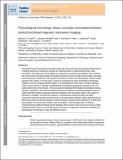Physiological Recordings: Basic Concepts and Implementation During Functional Magnetic Resonance Imaging

View/
Author
Gray, Marcus A.
Minati, Ludovico
Harrison, Neil A.
Gianaros, Peter J.
Critchley, Hugo D.
Published Version
https://doi.org/10.1016/j.neuroimage.2009.05.033Metadata
Show full item recordCitation
Gray, Marcus A., Ludovico Minati, Neil A. Harrison, Peter J. Gianaros, Vitaly Napadow, and Hugo D. Critchley. 2009. Physiological recordings: Basic concepts and implementation during functional magnetic resonance imaging. Neuroimage 47(3-8): 1105-1115.Abstract
Combining human functional neuroimaging with other forms of psychophysiological measurement, including autonomic monitoring, provides an empirical basis for understanding brain–body interactions. This approach can be applied to characterize unwanted physiological noise, examine the neural control and representation of bodily processes relevant to health and morbidity, and index covert expression of affective and cognitive processes to enhance the interpretation of task-evoked regional brain activity. In recent years, human neuroimaging has been dominated by functional magnetic resonance imaging (fMRI) studies. The spatiotemporal information of fMRI regarding central neural activity is valuably complemented by parallel physiological monitoring, yet such studies still remain in the minority. This review article highlights fMRI studies that employed cardiac, vascular, respiratory, electrodermal, gastrointestinal and pupillary psychophysiological indices to address specific questions regarding interaction between brain and bodily state in the context of experience, cognition, emotion and behaviour. Physiological monitoring within the fMRI environment presents specific technical issues, most importantly related to safety. Mechanical and electrical hazards may present dangers to scanned subjects, operator and/or equipment. Furthermore, physiological monitoring may interfere with the quality of neuroimaging data, or itself be compromised by artefacts induced by the operation of the scanner. We review the sources of these potential problems and the current approaches and advice to enable the combination of fMRI and physiological monitoring in a safe and effective manner.Other Sources
http://www.ncbi.nlm.nih.gov/pmc/articles/PMC2741582/pdf/Terms of Use
This article is made available under the terms and conditions applicable to Other Posted Material, as set forth at http://nrs.harvard.edu/urn-3:HUL.InstRepos:dash.current.terms-of-use#LAACitable link to this page
http://nrs.harvard.edu/urn-3:HUL.InstRepos:8160873
Collections
- HMS Scholarly Articles [17920]
Contact administrator regarding this item (to report mistakes or request changes)


